Why Managers Choose ShowUp’s Pulse Surveys Over Annual Engagement Surveys
“Employee surveys are dumb."
That was the opening statement in this article by Brennan McEachran, CEO & Founder of Hypercontext.
He went on to say:
They’re really, frustratingly dumb. They’re not the solution to the employee engagement crisis. They’re part of the problem.
The reason for Brennan’s outburst?
He spoke based on the established belief among managers about employee surveys being the key to engaging employees.
But is Brennan (a founder and manager himself) right? Are employee engagement surveys truly awful at solving engagement problems?
Let’s find out below.
The Problem With [Annual] Engagement Surveys
For context, you should know that there are two types of engagement surveys: annual surveys and pulse surveys.
This distinction is vital, and you’ll do well to keep it in mind as you read on.
Annual engagement surveys are the traditional surveys sent out yearly to workers in an organization. Most managers still try to use the feedback from this once-in-a-year event to improve engagement with employees.
Perhaps this approach worked in the past, but it doesn’t anymore.
Employees are no longer satisfied with providing feedback yearly. About 77% of employees want to provide feedback more than once per year, according to research by Qualtrics.
They want to feel like they have a voice in their workplace all year long.
When leaders and managers came to this realization, the use of annual employee engagement surveys decreased. In fact, a Gartner study showed the use of yearly employee surveys dropped from 89% in 2015 to 63% in 2020. This drop was in favor of other employee monitoring data approaches.
Helen Poitevin, Gartner’s Senior Director Analyst, shed more light on this:
The increased use of real-time analytics and recommendation engines has raised concern that feedback gathered from traditional engagement surveys every two years (or even yearly) is not frequent enough to provide a complete and current perspective.
In other words, annual surveys are too little, too late.
They don’t do much to provide enough information needed to make a change in employee engagement.
Now, back to the question raised earlier from Brennan’s statement:
Are employee engagement surveys awful at solving engagement problems?
In light of all that has been revealed so far, yes, engagement surveys (the traditional annual kind) cannot solve engagement problems.
Note the underlined phrase above.
Annual employee surveys are not such a great option for managers seeking growth through employee engagement. Sure, they have their uses, but they don’t do much to improve employee engagement.
Consequently, as the Gartner study revealed, managers have turned to other employee monitoring data tools.
One of such is pulse surveys.
Now, what makes pulse surveys a better alternative to annual surveys?
That’s what I’ll cover in this article.
You’ll also see how ShowUp, a team pulse survey tool, monitors employees’ pulses in real-time. Its distinct features help managers engage employees, improve company culture, and grow their companies:

Track, Measure, & Improve Your Company Culture.
Table of Contents:
Team pulse surveys, a better alternative to annual surveys
The term ‘Team pulse’ refers to the current state of your employees’ health. Just like humans, your team needs regular checkups and not a once-a-year kinda thing.
Jacob Shrirar, Officevibe’s director of customer happiness, said it best:
“Do you check your bank account once a year? Of course not; that would be crazy. So then why do we only check on our employees once a year?
These regular checkups will detect deviations and changes that affect engagement. Not only that, it will then help you embark on a corrective course of action.
Competent managers that want to build a better company culture keep their fingers on employees' pulse.
How?
By using team pulse surveys.
The term ‘pulse survey’ has been mentioned a few times in this article already. How about a definition?
What is a pulse survey?
You know how when a person is sick and goes to the hospital, the doctor first runs tests on the person before recommending a treatment. That’s similar to what pulse surveys do.
You can think of it as a diagnostic tool for managers.
This is because, with the real-time feedback received, pulse surveys help managers diagnose problems that staff face. This diagnosis allows the manager to take corrective action to improve his company’s culture and employee engagement.
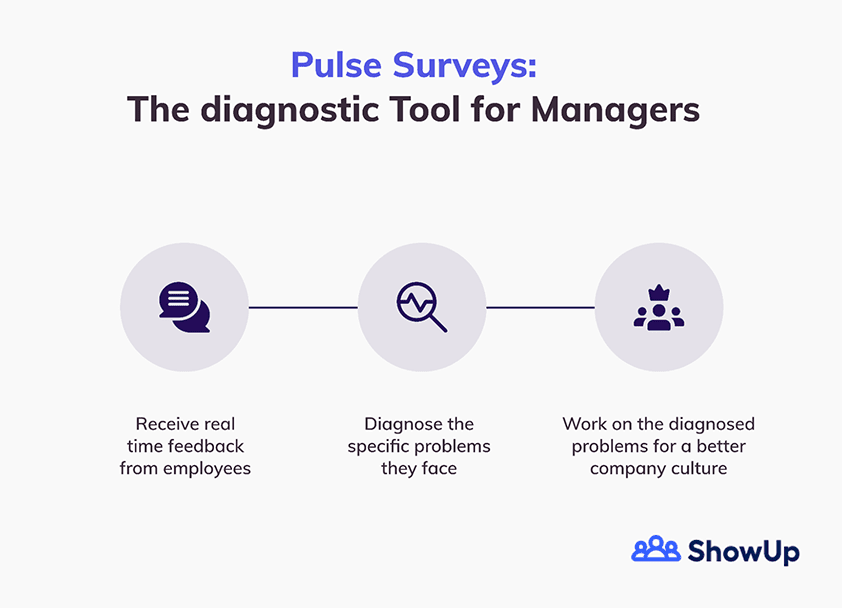
Jacob Shrirar also said:
By examining frequent, real-time feedback from employees, companies can make small, subtle changes that are highly focused but could have a big impact on engagement.
In other words, instead of guessing at the problems your employees are facing, you can know for sure in real-time with pulse surveys. Making changes based on this regular feedback highly influences employee engagement levels.
Pulse surveys are a condensed form of traditional annual surveys.
One similarity between them is that they are both engagement surveys (as established earlier). However, for employee engagement, pulse surveys have been credited as a better alternative to annual surveys. This is due to its characteristics and differences.
Below are a few of the differences:
Differences between pulse surveys and annual surveys
| Pulse Surveys | Annual Surveys |
| They are shorter, usually consisting of 5-15 questions completed in 2-3 minutes. | They are comprehensive and take a lot of time (about 20 minutes) to complete. |
| They are well-received by employees with an 85% response rate. | They have only a 30-40% response rate. |
| They are conducted weekly or bi-weekly for the best results. | They are conducted yearly (or, in some rare cases, every six months). |
| They give the manager real-time insights into employees’ pain points to be addressed before it is too late. | Since it is sent out yearly, it doesn’t afford managers early insights to address any issue before it worsens over the year. |
| With a team pulse tool like ShowUp, pulse surveys are better for solving employee engagement problems as the feedback received is relevant. | An Employee engagement software like Surveymonkey is terrible at solving employee engagement problems. This is because the feedback received might no longer be relevant because it takes too long to seek feedback. |
Now let’s talk about ShowUp, an automated team pulse tool for managers.
As a manager, ShowUp helps you keep a finger on your teams’ pulse to create a better workplace environment. Our tool follows a three-step process to measure employee pulse:
- Ask
- Analyze
- Act
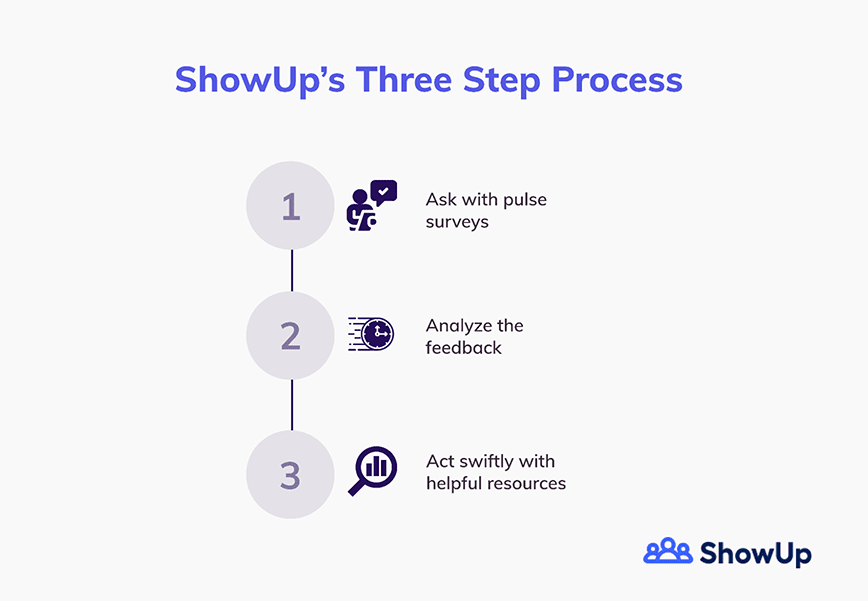
The Three-step process for measuring team pulse and increasing employee engagement
You see, the truth is employee engagement, and good company cultures don’t happen overnight. It’s a gradual process.
However, to drive change in an organization, start with giving your employees a voice. How do you give them a voice? By asking for feedback via carefully curated pulse surveys.
Vipula Gandhi, the Managing Partner at Gallup, corroborated this:
Only an objective, scientifically valid survey – combined with an analysis of performance outcomes – has the persuasive power to truly drive change.
The first stage in ShowUp’s three-step process to measure team pulse is the Ask stage. This is where ShowUp’s objective pulse surveys are sent out to the employees you manage.
In the next stage (analyze), ShowUp reports the survey results for easy comprehension and analysis.
And in the Act stage, which is the final stage, ShowUp helps you take proactive steps towards growing your company.
Let’s review in detail how each step works.
Build Your Company Culture with Pulse Surveys
Ask with pulse surveys
Annamarie Mann, Gallup’s Practice Manager & Consultant, was right when she said:
Asking questions that are ill-designed is one of the most common and avoidable mistakes in survey design. Very easily, questions can become misleading, too general, double-barreled, or simply confusing to the audience. And this can result in responses that are uninterpretable or unreliable
This totally makes sense.
Since the intent behind conducting a pulse survey is to improve engagement, it only makes sense to ask specific questions to reflect your intent.
The team at ShowUp understands this well. And so, after research validated by practicing psychologists, we identified 6 traits that managers should track to build a culture of innovation and employee engagement.
These traits/metrics include:
- Alignment
- Trust
- Respect
- Transparency
- Innovation
- Passion
It’s how we came up with 60 peer-reviewed and psychology-backed questions that provide actionable insights across all six traits or metrics:
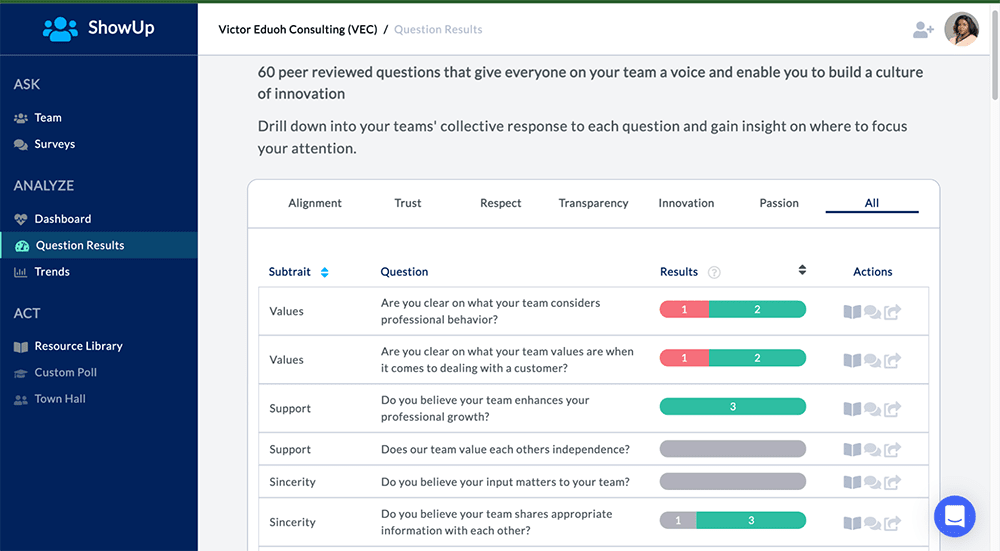
You can adjust the pulse survey settings to go out weekly or bi-weekly:
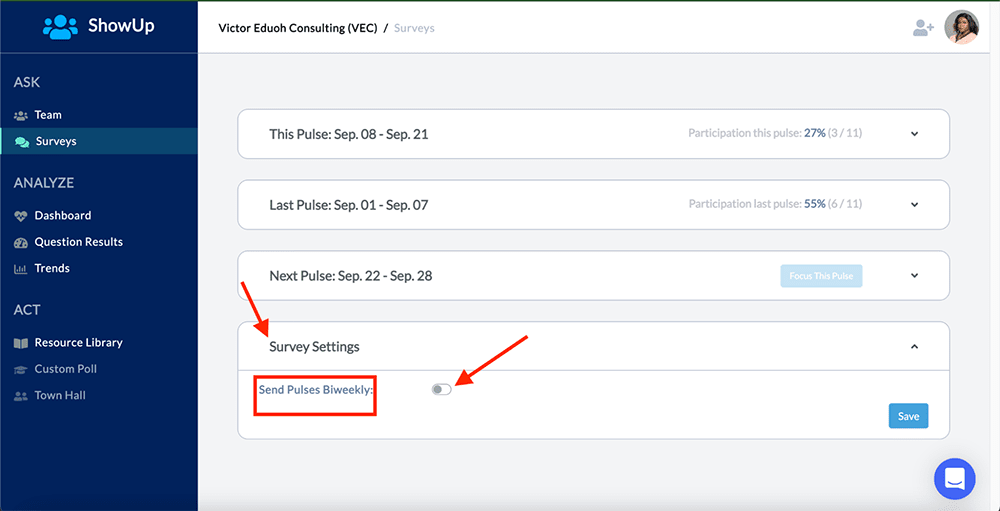
Each pulse survey contains 6 questions across all 6 metrics and sub metrics:
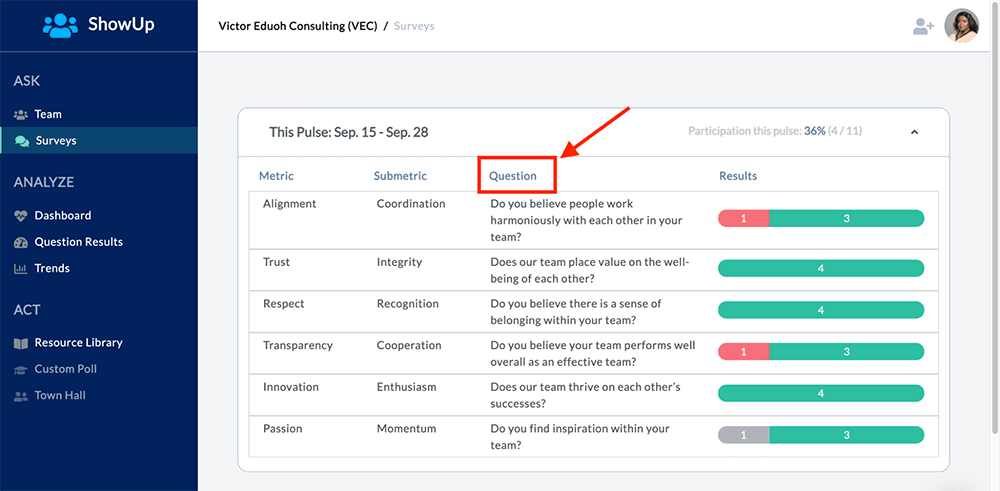
Depending on your preferred pulse setting, pulse surveys are sent out via email to your employees:
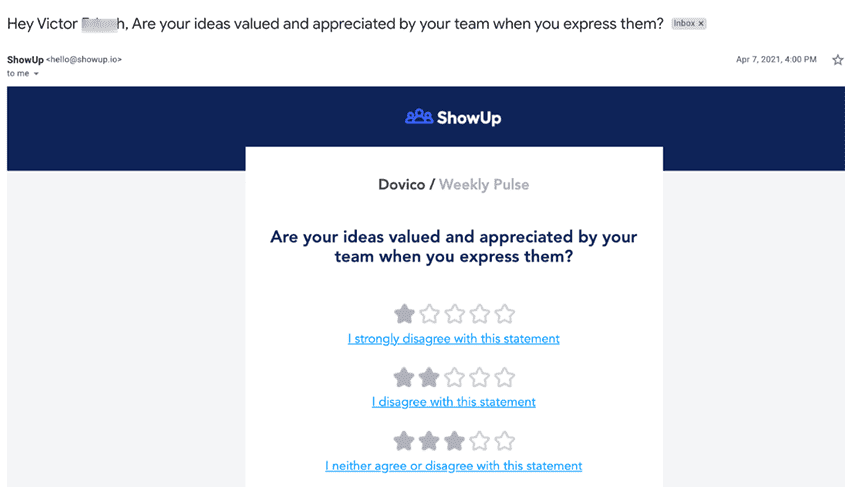
In one click, ShowUp smoothly transitions employees to respond using a 5-point Likert scale rating system:
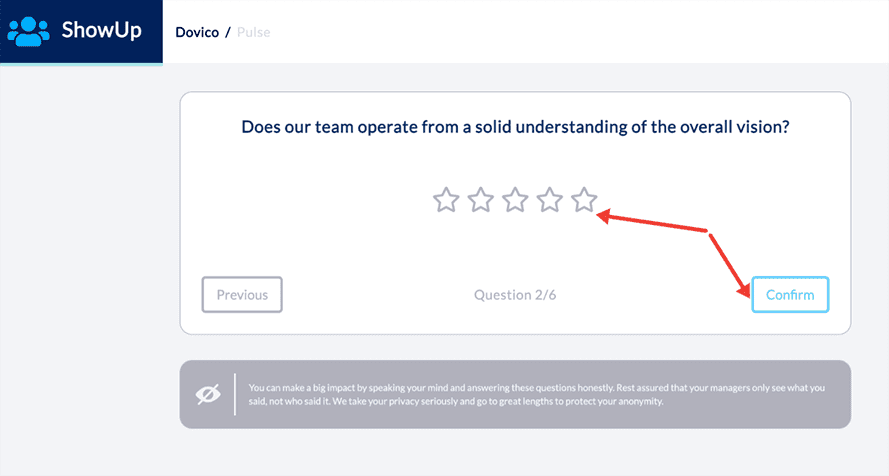
And voila!
Your employees are active and have lent their voice towards helping you build a better workplace culture:
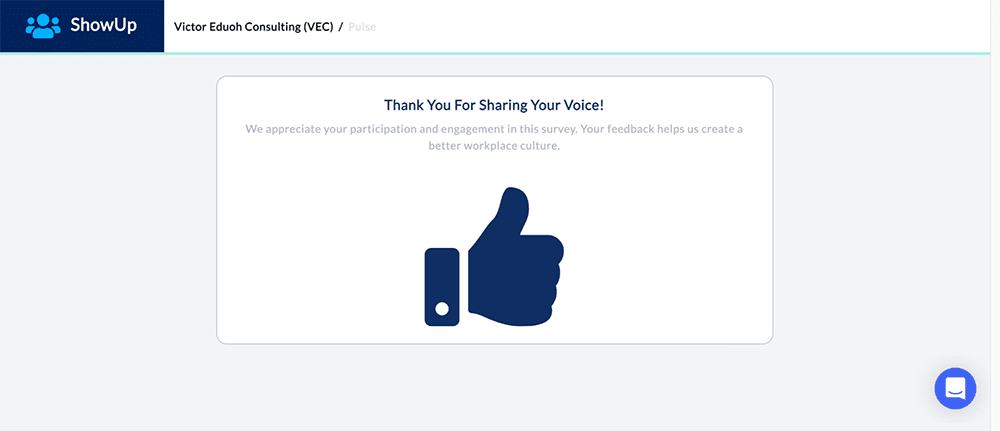
Another characteristic of ShowUp’s pulse surveys is that the responses are 100% anonymous. Why? We believe that in the quest to give employees a voice, you have to provide them with a safe space to do so.
By ensuring their privacy, two things happen:
1. First, the survey responses are honest and more accurate, leading to a successful survey. Holger Mueller, Vice President & Principal Analyst at Constellation Research, a technology research firm, says:
Ensuring privacy and anonymity of the survey tool is crucial for the success of its implementation. Anything less is a dead-end for a survey tool.
2. Secondly, employees will keep taking part in subsequent surveys. According to Dr. Palmer Morrel-Samuels, a Research Psychologist:
Respondents are much more likely to participate in surveys if they are confident that personal anonymity is guaranteed.
All these are why ShowUp anonymizes all the feedback you get:
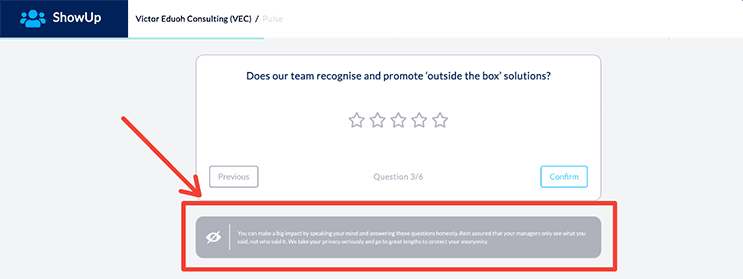
Analyze feedback
Evaluating the results from your pulse surveys is crucial and should be done immediately after you receive feedback. Now, say you have just 5-8 employees in your care. You might be able to go through the result individually to analyze the results.
But what if you have 15 employees or more?
That certainly won’t be easy. Remember, these surveys are sent out weekly or bi-weekly. So, coupled with other managerial duties, a manager with 15+ employees will have a hard time analyzing feedback and data.
And that’s where ShowUp’s analytics feature comes in.
After every pulse survey, ShowUp combs through the data received. It then presents a clear and detailed report of the data on your dashboard.
You can see your team’s strengths and the opportunities to improve in:
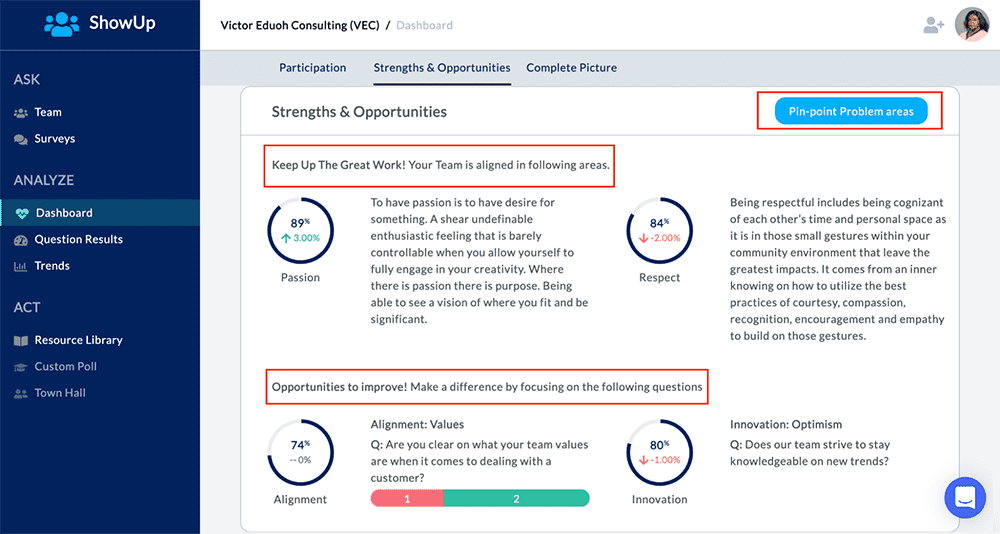
At a glance, it shows the participation rate of employees in these surveys over a period of time:
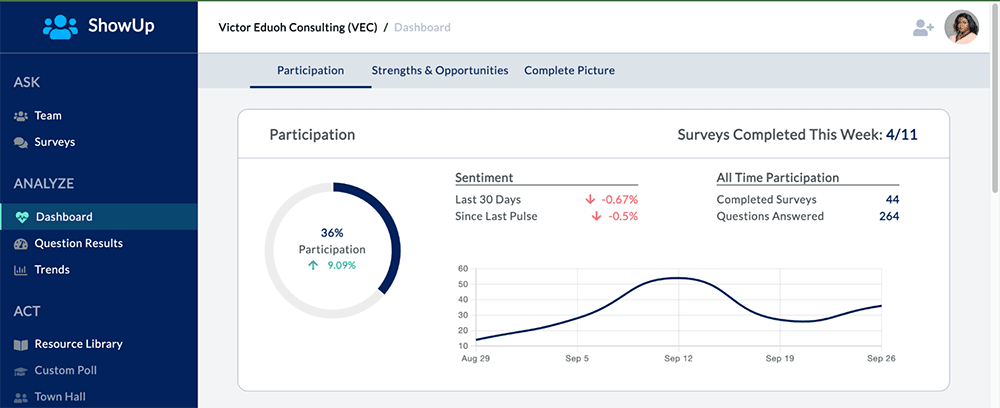
With bar charts to aid visualization, ShowUp presents a complete picture based on results over the past 30 days of the 6 metrics measured in the surveys:
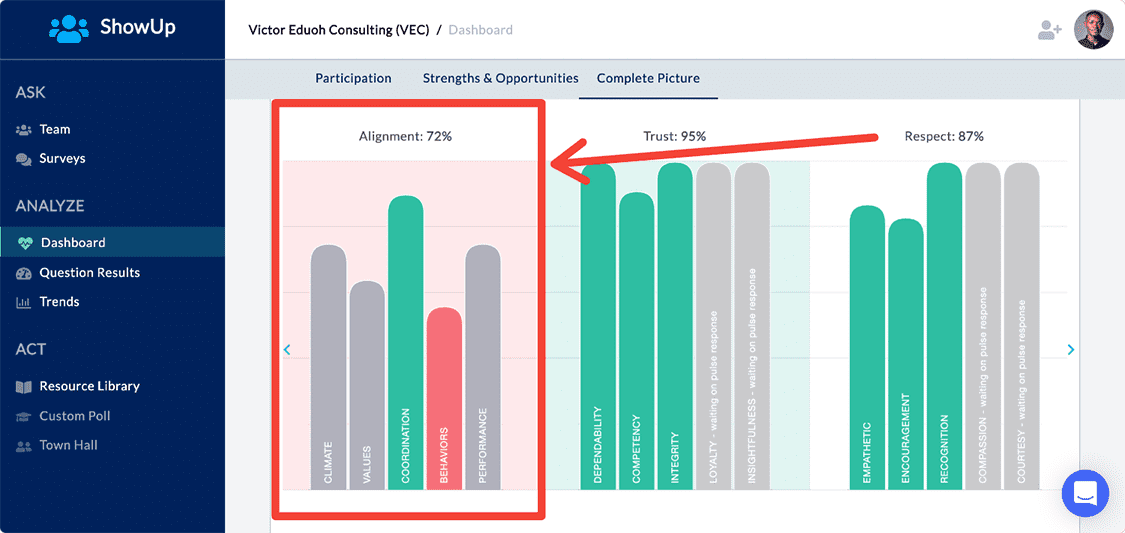
And with line graphs, a more detailed trend analysis of each metric over time is presented for your appraisal:

Act swiftly… with helpful resources
After receiving feedback and evaluating it, the next logical step is to take action. This requires you to follow a plan to improve on your weak areas. Like Vipula Gandhi, Gallup’s Managing Partner said:
It is important to create a post-survey action plan and make it a priority.
Failure to take the corrective and immediate action needed can result in:
- Lack of trust between managers and employees.
- Survey fatigue where employees are reluctant to answer subsequent surveys.
- Employee disengagement. According to research by TinyPulse, nearly 1 in 5 employees become disengaged when their company doesn’t act on the feedback received.
Not sure where to start?
ShowUp to the rescue.
With a pretty extensive resource library, the pulse tool recommends helpful resources pertinent to the problem areas its analytics features have identified.
These resources will prompt and help you swing into action to solve your employee engagement issues.
The resource library contains numerous resources that will help you create an action plan:

There you have it.
ShowUp’s three-step process helps keep your team engaged and aligned with the end goal of creating a better company culture.
However, there are some other features of ShowUp that help managers achieve this end goal. Interested in finding out more about these distinct features?
Check it out below.
Other distinctive features of ShowUp
- It has a great UI/UX, which makes it easy to navigate and use.
- Its automated and seamless mode of operation makes it a favorite team pulse tool among busy managers.
- It functions at full capacity without needing any form of integration.
- It comes pre-built with well-designed questions. This saves managers the stress of designing the questions themselves.
- The Pulse surveys can be re-focused. E.g., If you want to measure only passion in your workplace, you can adjust that setting.
- The pulse survey questions are engaging and straightforward, taking a few minutes to complete.
- Participants can only answer these surveys once to prevent duplication of results. Also, the surveys are open for a response for a specific window period (24-48 hours).
Give your team a voice with ShowUp
Do you know what all companies with great cultures have in common?
They give their employees a voice.
And that’s because they understand how crucial it is for employees to express their thoughts. You can give your employees a voice and show them you respect their opinions with Showup’s pulse surveys:
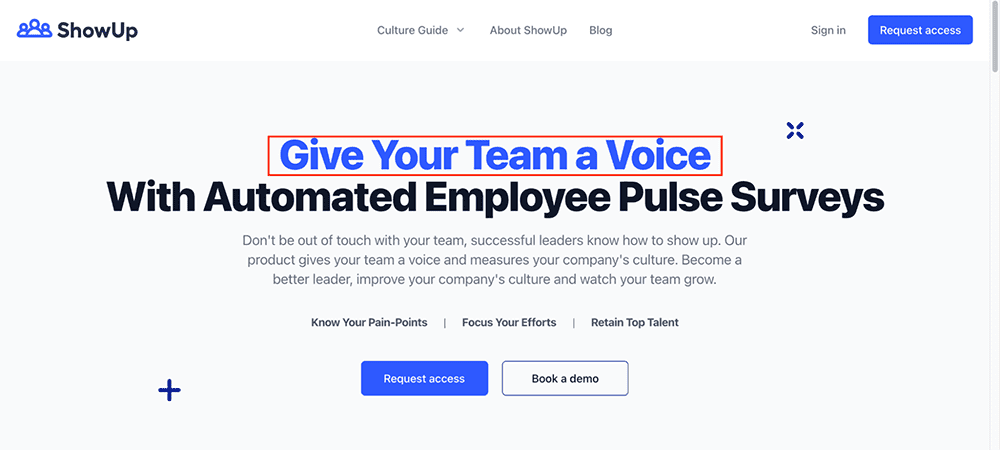
Scott Judd, Head of People Analytics at Facebook, said this in an article he co-wrote:
Not having a regular survey sends a clear message: you don’t care about people’s opinions. The act of filling out a survey gives them a specific channel for expressing their voice.
Measuring employees’ pulse should be a staple in your day-to-day operations. Once you begin to do that with ShowUp’s three-step process, there will be an upwards spike in your employee engagement levels. Doing this leads to more productivity, talent retention, and more sales.
